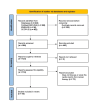A Systematic Review of the Cardiotoxic Effects of Targeted Therapies in Oncology
- PMID: 39238728
- PMCID: PMC11377122
- DOI: 10.7759/cureus.66258
A Systematic Review of the Cardiotoxic Effects of Targeted Therapies in Oncology
Abstract
Cancer therapy advancements have improved survival rates but also introduced significant cardiotoxic risks. Cardiotoxicity, a critical adverse effect of cancer treatments such as doxorubicin, trastuzumab, and radiotherapy, poses substantial challenges. This systematic review synthesizes findings from studies on cardiotoxicity induced by cancer therapies, focusing on detection and management. Key predictors of chemotherapy-induced myocardial toxicity (CIMT) include advanced age, hypertension, hyperlipidemia, diabetes, and elevated N-terminal pro-B-type natriuretic peptide levels. Regular echocardiographic assessments, particularly of the left ventricular global longitudinal strain (LVGLS) and left ventricular ejection fraction (LVEF), are essential for early detection. The CardTox-Score, incorporating these risk factors, shows high sensitivity and specificity in predicting CIMT. Advanced imaging techniques and biomarkers play crucial roles in identifying at-risk patients before functional decline. Early biomarkers and imaging techniques such as LVGLS and LVEF are effective in diagnosing and managing cardiotoxicity, allowing timely interventions. Cardiology involvement in patient care significantly enhances adherence to cardiac monitoring guidelines and reduces cardiotoxicity risks. Management strategies emphasize regular cardiac monitoring, patient education, and the use of cardioprotective agents. A collaborative approach between cardiologists and oncologists is vital to assess cardiovascular risks, minimize vascular toxicity, and manage long-term adverse effects, ensuring the safety and efficacy of cancer therapies. This review underscores the importance of early detection and proactive management of cardiotoxicity in cancer patients to optimize treatment outcomes and improve quality of life.
Keywords: cancer; cardioprotective; cardiotoxicity; chemotherapy; ejection fraction.
Copyright © 2024, Hauwanga et al.
Conflict of interest statement
Conflicts of interest: In compliance with the ICMJE uniform disclosure form, all authors declare the following: Payment/services info: All authors have declared that no financial support was received from any organization for the submitted work. Financial relationships: All authors have declared that they have no financial relationships at present or within the previous three years with any organizations that might have an interest in the submitted work. Other relationships: All authors have declared that there are no other relationships or activities that could appear to have influenced the submitted work.
Figures
References
-
- Cardiotoxicity of doxorubicin treatment and physical activity: a systematic review. Maia TN, de Araujo GBR, Teixeira JAC, Junior EDA, Dias KP. Int J Cardiovasc Sci. 2017;30:70–80.
-
- Cancer statistics, 2024. Siegel RL, Giaquinto AN, Jemal A. CA Cancer J Clin. 2024;74:12–49. - PubMed
-
- Anthracycline-induced cardiotoxicity: clinical course, risk factors, pathogenesis, detection and prevention - review of the literature. Wojtacki J, Lewicka-Nowak E, Leśniewski-Kmak K. https://medscimonit.com/abstract/index/idArt/508559 Med Sci Monit. 2020;6:411–420. - PubMed
Publication types
LinkOut - more resources
Full Text Sources

